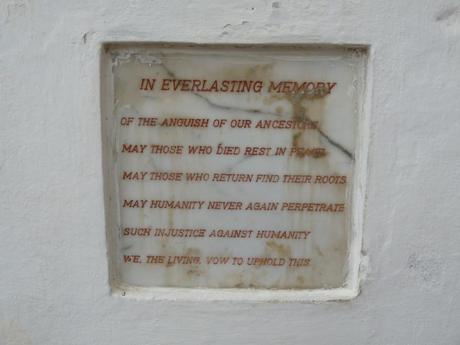Four hours after leaving Accra, through insane traffic jams, I reach Cape Coast. I am not sure this was the right thing to do today but I am here now. On the concrete expanse of the town square black and red canvas tents have been erected. The locals are dressed in their traditional clothes for a funeral day. Around the corner from this is Cape Coast Castle. With a warning from my driver to avoid the hawkers, I pay my entrance fee and join a tour group. I'm the only white in a group of twenty-five.
Outside the male slave room, the guide begins his tour. Although originally built by the Swedes, the castle was conquered by the British from the Dutch in 1664 and became the headquarters of the British administration of the Gold Coast. Less than twenty kilometres away is Elmina, the Portuguese castle and Dutch slave centre, but sadly these are only two and the most renowned of the many slave forts that still exist along the coastline. Originally these were strongholds for the trading of gold and ivory before they became the awful dark dungeons where masses of slaves would wait in inhumane conditions before being shipped across the Atlantic. Appropriately there are a few drops of rain as we listen. It doesn't seem right that the sun would shine here. I look around my group. There are three nuns in plain habits and two in colourful dresses with "Sacred Heart Catholic Church" badges. The guide points to the steep slope down into the shadowy chamber. Above us, built on top of the male slave room, is a church. This was the first Anglican church in Ghana.
We are taken into all five chambers of the male slave room. The chambers are dark. Now there are some spotlights to be able to see the way. During slave times there would have only been a couple of holes in the wall that would allow the sunlight in. Around two hundred men, chained together, would be held in each chamber. The first chamber was called the Strong Chamber. Slaves were measured for size and strength, the bigger the specimen, the better the price.
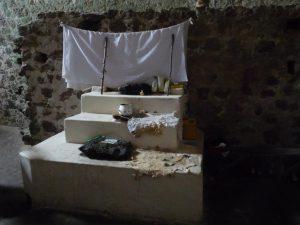
My eyes adjust gradually to the daylight back out on the courtyard. My brain cannot make sense of the sweeping white fortress in front of me, the stateliness of the building and the allure of the blue ocean it towers over. Black cannons sit proudly on the white castle walls. Beyond them the sandy beach is full of colourful fishing boats. Underneath my feet are the dungeons, plus two vast water wells and four graves.
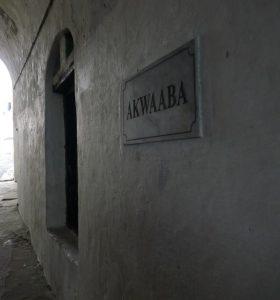
Under the castle walls are the women's cells. There were two separate cells where up to five hundred women were imprisoned. Often raped by the white guards, their babies would be taken to local schools and then subsequently sent to the plantations as supervisors due to their lighter skin. Those women who were strong after pregnancy returned to the slave rooms. The weaker ones were either shunned or more usually killed.
I notice outside one of the chambers, a sign on the wall says, "Akwaaba." This means 'welcome' in Twi (the local language). I can't make much sense of anything here and I definitely don't understand this.
Next to these cells, at the end of the sloping passageway, is the Door of No Return.
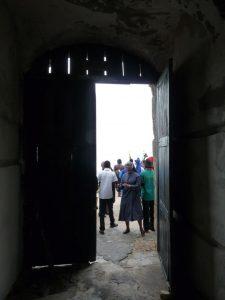
Now full of local fishermen and other traders, the beach behind us was then for white men only. As we listen to the narrative, a scrawny kid begs me for money and a few women try to sell their food. The boy then hassles one of the nuns. The guide interrupts his presentation to move him away and advises the nun to protect her bag.
We go back inside. From this side, the door is labelled the Door of Return.
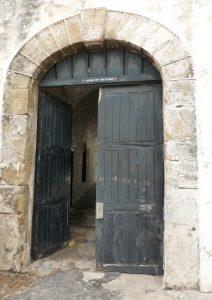
We are shown the cells where unruly prisoners would be kept. It's an old storeroom with no natural light. The three locked doors would only be opened once all the prisoners were dead. It's absolutely shocking. I am numb, constantly shaking my head at what I see and hear.
The group now follows the guide upstairs. I was not prepared for the luxury of the large room where McLean would hold court and, beyond it, his grand bedroom and chambers. Fourteen large windows allow the light and sea breeze to flood in. It's a total contrast to the dark, hot slave chambers beneath us. How could anyone sleep peacefully here?
On the way out, I pass a plaque on the wall.
In everlasting memory Of the anguish of our ancestors. May those who died rest in peace. May those who return find their roots. May humanity never again perpetuate Such injustice against humanity We, the living, vow to uphold this.